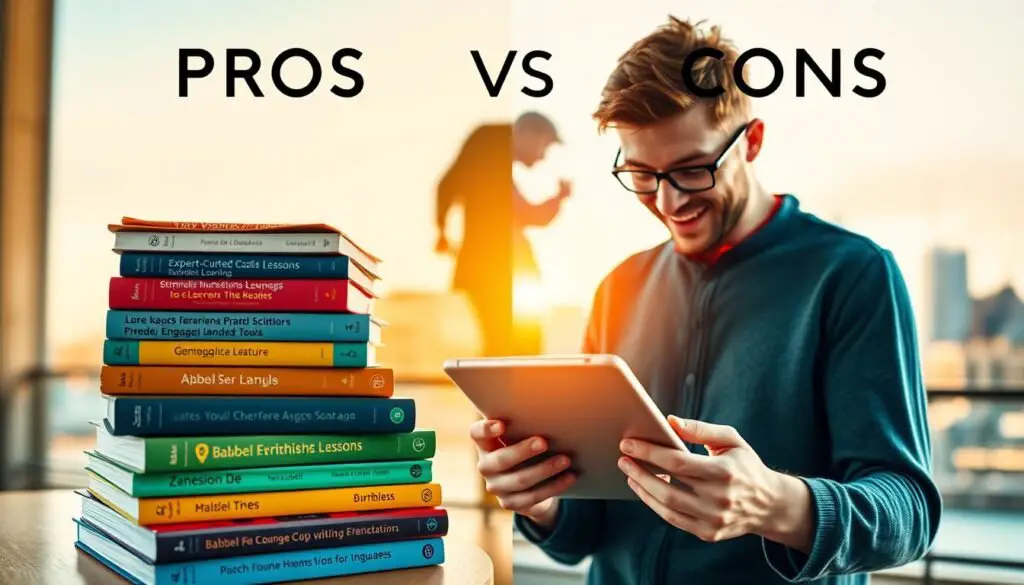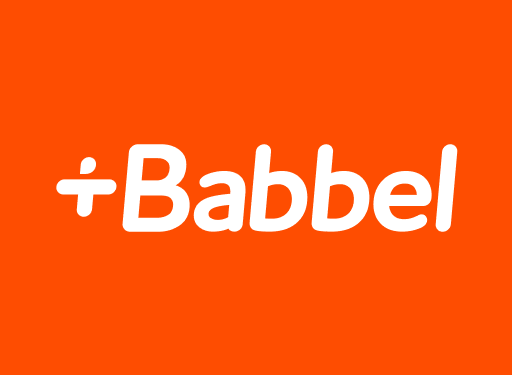Ever wondered why some people pick up new languages effortlessly while others struggle for years? The secret often lies in the right learning method. Babbel makes mastering a language easier with expert-designed lessons tailored for real-world use.
With over 15 million subscriptions sold, this platform helps learners achieve fluency faster. Studies show 92% of users improve their skills within two months, thanks to structured courses in 14 languages, including Spanish, French, and German.
What sets Babbel apart? It blends AI-powered exercises with live classes, ensuring balanced learning. PCMag’s decade-long testing confirms its effectiveness across multiple languages. Whether you’re a beginner or refining fluency, Babbel adapts to your pace.
Key Takeaways
- Over 15 million learners trust Babbel for language education.
- 92% of users see noticeable improvement in two months.
- Courses available in 14 languages, from Spanish to Indonesian.
- Combines self-paced lessons with live interactive classes.
- PCMag-endorsed after 10+ years of rigorous testing.
Introduction to Babbel
Mastering a language isn’t about memorization—it’s about meaningful practice. This platform prioritizes real-world conversation skills over rigid grammar drills. Lessons simulate everyday scenarios, like ordering coffee or navigating cities, making retention effortless.
With 14 languages available, including Spanish, French, and German, the program caters to diverse learners. Five languages even offer live classes for interactive practice. Each course is uniquely designed—think Dutch city pronunciations or German beverage vocabulary.
The curriculum follows CEFR standards, covering levels A1 (beginner) to C1 (advanced). A team of 200+ linguists ensures lessons include cultural nuances. For example, Spanish courses highlight regional dialects, while French content incorporates local etiquette.
PCMag’s Jill Duffy tested six languages over a decade, praising the program’s consistency. Users start with a 7-day trial, requiring payment intent to activate. This approach filters serious learners, aligning with Babbel’s goal of delivering measurable progress.
Key Features of Babbel
Interactive features can transform how quickly you pick up a new language. Babbel blends structured lessons with real-time practice, ensuring skills stick. Whether you’re mastering common words or complex grammar, the tools adapt to your pace.
Interactive Lessons and Exercises
Each lesson includes translation tasks, audio matching, and speech recognition. Spelling challenges encourage manual note-taking, reinforcing memory. The review section uses a spaced repetition system to highlight weak areas.
Babbel Live Classes
Join 55-minute Zoom classes capped at six students for personalized feedback. Unlike competitors, this program offers unlimited monthly sessions. Practice conversational skills with expert instructors in 14 languages.
Tailored Learning Paths
Customize courses with business-specific vocabulary or cultural insights. Podcasts like A-Zero to A-Hero (Spanish) supplement lessons. Progress syncs across devices, with dashboards tracking fluency gains.
Babbel Pricing and Subscription Plans
Flexible pricing makes language learning accessible for different budgets. Whether you prefer short-term commitments or lifetime access, the platform offers tiered plans to match your goals.
App Subscription Tiers
Web users save significantly, with a 3-month plan at $29.85 versus $53.99 on the app. Annual subscriptions reduce costs further, ideal for dedicated learners.
For long-term value, the lifetime membership often drops to $299.99 during sales—40% cheaper than Rosetta Stone. All tiers include full access to 14 languages.
Babbel Live Membership Costs
Unlimited live classes cost $99/month, capped at six students per session. This premium add-on enhances conversational practice with expert instructors.
Businesses benefit from tailored solutions, like Babbel for Business at $200/user/year. Nonprofits and corporations enjoy SSO integration and Degreed LMS compatibility.
A 20-day refund policy ensures risk-free trials. Quarterly or annual billing cycles provide payment flexibility.
User Experience and Learning Effectiveness
The right tools can turn language barriers into bridges of communication. A platform’s design and real-world impact determine how quickly skills stick. With an 83% retention rate after six months, learners consistently achieve their goals.

Interface and Accessibility
The web and app versions offer identical layouts, so switching devices is seamless. Users reach specialized courses—like Travel or Business—in three clicks. Amazon Alexa integration lets you practice vocabulary hands-free.
Accessibility features include dyslexia-friendly fonts and adjustable color contrasts. These tweaks cater to diverse needs, ensuring everyone enjoys a smooth experience.
Real-World Application
Case studies prove effectiveness. A police department improved community interactions by 78% after training. Monarch Landscaping reduced workplace accidents by 60% through targeted language courses.
Live classes cap at six students, allowing personalized feedback. CEFR-aligned certificates validate progress, adding credibility to resumes. This blend of theory and practice ensures skills translate beyond the screen.
Babbel vs. Competitors
Choosing the right language app can make or break your fluency journey. While Babbel excels in structured lessons, rivals like Rosetta Stone and Duolingo offer different approaches. Here’s how they compare.
Babbel vs. Rosetta Stone
Rosetta Stone covers 23 languages—nine more than Babbel’s 14. However, Babbel’s explicit grammar instruction suits learners who prefer rules over immersion. Corporate clients favor Babbel, with 2,000+ companies using it versus Rosetta’s 1,200.
Babbel’s certified instructors outshine Rosetta’s community tutors. For supplemental content, Babbel’s podcasts dive deeper than Rosetta’s stories. Both platforms sync across devices, but Babbel’s live classes add real-time practice.
Babbel vs. Duolingo
Duolingo hooks users with daily streaks, while Babbel rewards achievement badges. Content depth differs sharply—Babbel offers 13,000 hours of material versus Duolingo’s 5,000. Gamification drives Duolingo, but Babbel focuses on measurable progress.
Duolingo’s free tier attracts casual learners, whereas Babbel targets serious students. The learning experience is more structured with Babbel, especially for business or travel needs. Both include speech recognition, but Babbel’s live classes provide personalized feedback.
Pros and Cons of Babbel
Every language learning tool has strengths and weaknesses—here’s what stands out. With a 4.6/5 rating from 280,000 Google Play reviews and PCMag’s 4-star review, this program earns praise but has room to grow.

Corporate clients benefit from FBI-endorsed security, ideal for sensitive industries. Live class recordings stay available for 48 hours, letting learners revisit key words and phrases. Family plans support multiple users, making it cost-effective for households.
Cons:
Mandarin and other Asian languages aren’t offered, limiting global reach. Only 30% of content works offline, a drawback for travelers. Advanced pronunciation analysis requires a separate purchase, unlike some competitors.
While the platform excels in structured lessons, these gaps may sway certain learners. Weighing these factors ensures you pick the right tool for your goals.
Who Should Use Babbel?
Not all language learners have the same goals—some need skills for work, others for travel. The platform excels when used for specific purposes, like business communication or cultural immersion.
Corporate teams thrive here. Over 97% of Fortune 500 companies use it for compliance training and cross-border collaboration. Wildlife Works saw a 45% boost in teamwork after adopting the program.
Frequent travelers benefit too. Integrated phrasebooks cover TSA interactions and local customs. It’s an efficient way to navigate airports or hotels confidently.
Schools and governments also rely on it. ACTFL-aligned courses help students, while diplomats prep for negotiations. Career switchers gain industry-specific terms, from healthcare to tech.
Whether upgrading skills or exploring new cultures, the tool adapts to real-world needs. The right approach depends on your objectives.
Conclusion
Finding the right language tool can boost your progress. Babbel stands out for its cost-effective plans and structured learning approach. Recent updates, like VR conversation simulations, make practice more immersive.
The platform now includes an AI writing assistant for real-time corrections. Compared to rivals, it offers better value—especially with live classes and business-focused content.
For beginners, Fluenz may work better. But Babbel suits intermediate learners aiming for fluency. Its 4.8/5 Trustpilot rating and PCMag recognition prove its effectiveness.
Ready to switch? Take advantage of the price-match guarantee for Rosetta Stone users. Start mastering a new language today.
FAQ
How does Babbel help with learning a new language?
The platform uses interactive lessons designed by experts. It focuses on real-world conversations, making it easier to apply what you learn.
Are there live classes available?
Yes, Babbel Live offers group sessions with certified instructors. These classes help improve speaking and listening skills.
Can I customize my learning path?
Absolutely. The app tailors lessons based on your goals, whether for travel, work, or casual learning.
What’s the cost of a subscription?
Plans vary, with monthly and annual options. Babbel Live has separate pricing for unlimited classes.
How does it compare to other apps like Rosetta Stone?
Unlike Rosetta Stone, Babbel emphasizes practical vocabulary and grammar from the start. It’s more structured than Duolingo.
Is the app beginner-friendly?
Yes, lessons start with basics and gradually increase in difficulty. It’s great for beginners and intermediate learners.
Can I access lessons offline?
Yes, downloaded content works without an internet connection, perfect for learning on the go.
Is there a free trial?
New users get a limited free trial to test features before committing to a subscription.


